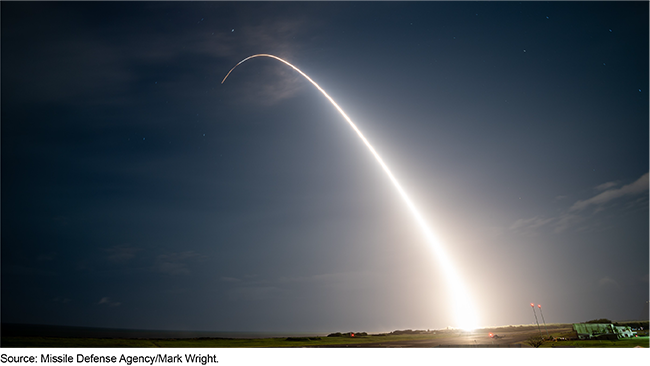Missile Defense: Annual Goals Unmet for Deliveries and Testing
Fast Facts
The Department of Defense's Missile Defense Agency develops systems to detect attacks and track, intercept, and destroy missiles in flight. Every year, MDA sets goals for the systems it plans to deliver to the military and the tests it plans to conduct.
We found that MDA did not meet these goals in FY 2022. The agency didn't deliver all of its planned interceptors and radar upgrades. MDA also didn't complete its planned flight, ground, or cyber tests for its systems.
We've made a number of recommendations in past reports that could help MDA meet its annual goals.
A target is launched during a Missile Defense System flight test from the Pacific Missile Range Facility in Kauai, Hawaii

Highlights
What GAO Found
The Missile Defense Agency (MDA) is charged with defending the United States, its deployed forces, and regional allies from missile attacks. MDA executes this mission through a layered system of capabilities, known as the Missile Defense System. Individual systems known as elements—for example, interceptors intended to destroy missiles in flight—provide these capabilities.
In 2022, MDA continued to deliver interceptors and radar upgrades to operational commanders, including those that were expected to be delivered in prior years, but it did not meet its annual goals. As a result, the warfighter has less fielded capability than planned. One element—the Terminal High Altitude Area Defense system—met its 2022 delivery goals. MDA did not complete its fiscal year 2022 flight, ground, and cyber baseline test program, consistent with prior years.
Missile Defense Agency Test Program Activities in Fiscal Year 2022

Examples of MDA's fiscal year 2022 baselined test program results follow:
Flight testing: Flight tests use actual hardware to demonstrate or assess system performance. MDA conducted six of nine planned tests, and met objectives in five of those six tests.
Ground testing: Ground tests use simulations to model capabilities and limitations in a wider variety of potential situations than flight tests. MDA conducted a key ground test—originally planned for fiscal year 2020—intended to support decisions necessary to increase capability to defend the United States. However, MDA conducted three of nine planned ground tests, deleting or delaying the tests not conducted to future fiscal years.
Cyber testing: Cybersecurity operational assessments evaluate cyber defense capabilities and vulnerabilities. MDA conducted two such tests in fiscal year 2022—about a year later than planned—but scaled back the scope of these tests and delayed five other tests to future years.
Why GAO Did This Study
Since MDA was established in 2002, the Department of Defense has spent over $194 billion, including $10.4 billion in fiscal year 2022. This spending was intended to equip operational commanders with a network of missile defense-related sensors, interceptors, and command and control capabilities. Over this time, missile threats from foreign adversaries have evolved, and MDA has faced persistent challenges as it attempts to keep pace. GAO has reported that MDA has not met the annual goals it sets for itself to deliver hardware and test its capabilities.
Congress included provisions in legislation for GAO to annually assess MDA's progress toward meeting its acquisition goals. This report—the 20th in this series—addresses the extent to which MDA (1) achieved its fiscal year 2022 baseline delivery goals and (2) completed its testing planned for fiscal year 2022. To conduct this work, GAO reviewed MDA's baseline reports, test plans, and the agency's responses to detailed question sets. In addition, GAO reviewed information provided by MDA contractors and DOD officials.
Recommendations
As of June 2022, there were 23 previously issued recommendations that have not been implemented. GAO continues to believe that implementing these recommendations related to testing, transparency, and cost reporting would help address acquisition issues.
